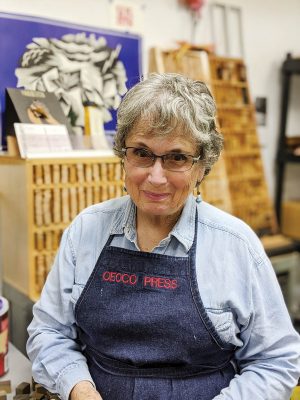By Katie Bohannon, News Editor
The Gadsden Museum of Art is welcoming audiences to witness a lifelong collection of work in its current exhibit, “A Presentation by the One-eye Opera Company and OEOCO Press” by Ragland-based artist Mary Ann Sampson. Featuring mixed media works and handmade books, the exhibit reflects on the various artistic eras of Sampson’s life, emerging as a powerful stage for a personal performance.
Born in eastern North Carolina, Sampson grew up in a little town called Smithfield, where she lived across from the school. A creative child who possessed a fascination for theater, she improvised scripts with her fellow actresses and two sisters, performing grand imaginative plays for her aunt, who sat outdoors and watched each plot unfold from behind curtains hung on the clothes line. When school let out, passersby would often linger at their shows, forming a captive audience in Sampson’s own yard.
An appreciation for agriculture coincided with Sampson’s artistic nature, as she frequented her grandparents’ home, who raised, barned and cured tobacco. She loved the community centered around the plant’s cultivation and the wonder she discovered in playing outdoors. She picked cotton, cut eggplants and prepared peppers for the market. While the philosophies of the 1940s and the traditions of the South rarely placed artists on pedestals, Sampson considers her childhood the genesis of her innovation, sprouting from play rather than a classroom.
Sampson exercised her imagination and enriched her connection to the earth at an early age, making houses from the roots of Oak trees, which sprout from the ground like little gnarled rooms.
She never owned a formal play house – acorns, leaves and sticks were a world of possibility for her, not constrained to a specific purpose, but filled with endless potential.
“I love the soil,” said Sampson. “That’s a part of my life. I feel lost without it. I live out in the country in St. Clair County, because I always wanted to return to the earth. I think it’s very primal; it’s so there. You can touch it. You can manipulate it. I’ve been around agriculture all my life. I love to garden, and I like to grow flowers. That’s what I do now. I don’t grow anything you could eat, except maybe a few tomatoes! A lot of these things connect in our lives. We’re not aware of them unless we think about it and examine how things influence us.”
Sampson associates her first feeling of artistic inspiration to her cousin, Ruth Faison Shaw. An educator and artist herself, Shaw taught in Paris and directed the Shaw School in Rome for English speaking children. Through her observations of how children enjoy smearing paint, Shaw originated the practice of finger-painting, which influenced Sampson to make similar creations at home.
Prior to her career as an artist, Sampson pursued nursing following high school, studying at Wake Forest School of Medicine. She learned how to interact with patients and communicate with others, gaining maturity while serving on a pediatric unit.
“Everything I learned in nursing was so important, and still is important, about human interaction and pain and troubles,” said Sampson. “How is that person feeling? Empathy was one of the key words I learned about interaction between people.”
While Sampson learned essential lessons as a nurse, her desire to be an artist proved one difficult to repress. Following her migration to Alabama with her husband, who pursued a residency at The University of Alabama in Birmingham and later practiced medicine in the city, and the birth of their daughter Anna, Sampson felt a nudge to travel down a different path.
Sampson began taking courses at Birmingham Southern and Samford, where she double majored in Spanish and art. A lover of languages, Sampson’s passion for words coincides with her appreciation for art – both forms of expression and communication between people.
“I like people,” said Sampson. “I like to know what they’re about first. That’s how I engage strangers. Some people just don’t like to talk about themselves, but I think if you engage someone in a conversation and try to see how they look at the world, that gives you a way to communicate. Communication is very important – not through electronics. It’s so important to learn how to converse, to learn how to talk to other people. I think we’re all like other people, most of us. We’re gregarious as humans…that’s a part of our basic nature as people.”
When Sampson graduated from college, she was able to slow down, self-teach and experiment with different mediums and techniques. Among her favorites are pencils, water soluble paints and inks for “spreading color and quietness, to get away from the whiteness of paper.” She loves working with linen thread and leather, envisioning the different materials and ramifications of her final product, setting a goal and working towards achievement.
“It’s a process,” said Sampson, about creating her art. “I keep a journal, sketch books. There’s something about the freedom of sketching, allowing the mind to go think on subject. Then, you expand on that subject and you draw from that. These are ideas. they may never come to fruition, but eventually you might hit on something you’d like to expand on. That’s how a lot of my work goes. I like the whole idea of process in art. I think that’s a key thing I’ve realized – from beginning to end and all between, that’s where the joy is.”
Sampson spent some time working in a friend’s studio in downtown Birmingham that included an etching press, where she met fellow artists who shared her interests. She discovered a desire to own her own studio and return to school to obtain an Master’s degree, which she did at a later date, earning an M.F.A. in Book Arts from the University of Alabama. Yet, it was a trip to Richmond, Virginia, that sparked an interest Sampson could never quench, introducing her to the world of artists’ books.
“I just thought, ‘I love this,’” said Sampson. “It’s my thing. It’s got words, it’s paper, it’s sculptural, it’s something you can draw in and it’s something you can print. You can control all this. It blew my mind. I changed direction at that point and the next thing I did was begin to take advantage of some learning.”
Taking advantage of learning manifested in the form of lectures with prominent figures in book artistry like Keith Smith and Timothy Ely, who challenged Sampson during workshops. She formed friendships with the faculty in Tuscaloosa and other artists, sharing her work with the public. Her knowledge eventually filtered into her own studio, which she lovingly titled “The One-Eye Opera Company” and “The OEOCO Press,” which creates limited-edition letterpress and unique books, which Sampson founded.
A series of artist books followed. Sampson’s first book, Another Opera, featured endless experimentation, from drawing to sewing to painting. Since then, she has produced hundreds of books, even collaborating with other artists and poets to create beautiful, intriguing and one-of-a-kind treasures.
In her book-making and other art forms, like drawing, painting and sculpture, Sampson explores numerous themes that arise in life. Emotional motifs depict motherhood, the power of storytelling and draw from Sampson’s theatrical roots, emerging in sketches of configured faces, hands and bodies that mimic cellists in symphonies or strip back layers, exposing anatomical features like the human nervous system.
Sampson captures moments she witnesses in life and gives them a home in her artwork. Mismatched colors and contrast between positive and negative space overlap in grids, forming a puzzle that allows images to appear while others fade away, hiding messages throughout each piece. One drawing includes a depiction of men torturing a snake, an actual sight she witnessed at a filling station.
“That’s the theatrical aspect of these,” said Sampson. “Life is chaotic. The opera has played on that so much. It’s usually tragedy and drama and people singing their hearts out. It’s a little spot in the life of humanity…it’s an art form in itself. It has its own formula and ways of presenting it to the world. I see this chaos and I like the way I can play with it, [in a manner where] it doesn’t do anybody any harm. I enjoy these characters all scrambled up. I love what I do. You may not like it, and it’s not for your sofa, but that’s okay! It’s my way of expressing how I feel about life and my reinterpretation of my experiences.”
Sampson understands that art is something that attracts different audiences, and she never takes offense to anyone who does not enjoy her particular work. She expressed her excitement at introducing her lifelong collection to the public in Gadsden, noting that several pieces featured in the current exhibit have never been viewed by outside eyes. She shared what she treasures the most about creating art.
“That process of not worrying about anything else in the world other than what you’re doing is what I enjoy the most,” said Sampson. “It’s a wonderful feeling. You can focus right on what you’re doing. That’s true in anything. If you’re writing a letter, pour your heart into that letter. Do the best you can with that.”
From Sampson’s playful childhood that sparked an adulthood enriched in imagination, to her continual creative nature that beckoned endless books forth, to her ingenious ability to perceive life with all its elements, layers and intricacies in powerful tangible interpretations, Sampson’s exhibit emerges as a lifelong collection of her contributions to the artistic world. Her work has been featured in more than 50 venues, including Washington, Atlanta, Canada, Chicago, New York and Germany. Through her partnerships with fellow artists to her students in Ragland and Jacksonville, Sampson’s influence proves paramount, touching all who know her and leaving an incredible legacy in her wake.
“Each person who makes art has their own signature,” said Sampson. “It’s the individuality of any artwork. If you’ve made artwork for 30 or 40 years, you’re going to see a stream of similarities come out. I find that true in watching artists at the end of their career, looking at their work. You see all these tendencies. They’re like your thumbprint. This [exhibit] is really my thumbprint on life – and I’ve enjoyed my journey.
“As people, you need to express. I’m not going to say free expression, because a lot of it is not free. You take what you’ve learned and the skills you’ve learned. I’m particular about skills; I feel like I’ve spent a lot of time to discipline them. I learned how other people in the profession look at your work. They’re more interested in how it’s built, is it going to fall apart. You live in a world of lots of opinions, but you do have to feel strong about your work. This is what I have to give – take it or leave it. Enjoy life. There’s a lot of wonderment about life. That’s how I feel about it…I just love it. I’m glad I’ve got my play-place in the world.”
Interested audiences are welcome to view Sampson’s show at the Gadsden Museum of Art until April 30.





